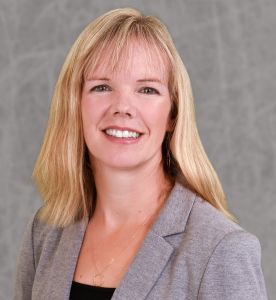Chemistry Ph.D. Student Unlocks the Secrets of the Body’s Molecular First Responders

At the 73rd American Society for Mass Spectrometry (ASMS) conference in Baltimore in June, Amie Solosky, a Ph.D. chemistry student in the Baker Lab, presented a powerful story about some of the body’s smallest—and most elusive—molecules.
July 21, 2025 | By Dave DeFusco
At the 73rd American Society for Mass Spectrometry (ASMS) conference in Baltimore in June, Amie Solosky, a Ph.D. chemistry student in the Baker Lab, presented a powerful story about some of the body’s smallest—and most elusive—molecules. Her research could help uncover hidden signs of disease and improve how we understand our body’s response to inflammation, diet and environmental stressors.
Most people have heard of fats, oils and omega-3s, but far fewer know about oxylipins, which are tiny, oxidized fatty acids that act like molecular messengers. These compounds help regulate inflammation, and some researchers believe they could be key players in everything from diabetes and heart disease to how our bodies respond to pollution or COVID-19.
Yet despite their importance, oxylipins have remained frustratingly difficult to study because they often appear in vanishingly small amounts in the body, and many of them look almost exactly alike at the molecular level.
“These molecules are really tricky,” said Solosky. “Many oxylipins share the same mass and even similar chemical structures. That makes them hard to tell apart, especially when we’re trying to analyze hundreds of them at once.”

Solosky is working to change that. Her dissertation centers on building one of the most advanced databases in the world for oxylipins complete with highly precise measurements that help distinguish these near-identical compounds from one another.
“Amie is very passionate about providing the worldwide scientific community with this expansive oxylipin resource,” said Dr. Erin Baker, Solosky’s advisor and an associate professor in the Department of Chemistry. “She knows it will vastly increase the number of oxylipins currently being evaluated and aid in determining potential oxylipin biomarkers for diagnosing and treating health conditions.”
Lipids, which are molecules that include fats and oils, are essential to life. They make up our cell membranes, store energy and help send chemical signals throughout the body. Oxylipins are a special subgroup of lipids derived from polyunsaturated fatty acids like omega-3s and omega-6s, which we typically get through food.
“Oxylipins are like the body’s emergency response team,” said Solosky. “They kick in during injury or illness and help regulate inflammation and healing.”
But if oxylipins get out of balance, they can become part of the problem instead of the solution. Scientists have linked abnormal oxylipin levels to heart disease, Type 2 diabetes, Alzheimer’s disease and even severe COVID-19. They’re also suspected of being affected by harmful environmental exposures.
That makes them a potential goldmine of information—but only if researchers can accurately identify and measure them. Solosky’s biggest challenge lies in identifying isomers, which are molecules that have the exact same chemical formula but slightly different structures. These subtle differences can lead to very different biological effects. For instance, one isomer of an oxylipin might trigger inflammation, while another might help reduce it.

Standard lab techniques struggle to tell these isomers apart. “It’s like trying to identify twins based only on their height and weight,” said Solosky. “They’re almost indistinguishable without more advanced tools.”
So Solosky turned to a cutting-edge approach that combines three different techniques into one powerful system:
- Liquid chromatography (LC), which separates molecules based on how they interact with a sorbent material, like how ink separates into a few different colors when applied to a wet paper towel;
- Drift tube ion mobility spectrometry (DTIMS), which sorts them by size and shape as they drift through a gas-filled tube; and
- Mass spectrometry (MS), which measures their mass-to-charge ratio with extreme precision.
Together, this multidimensional platform—called LC-DTIMS-MS—let Solosky isolate some of the most stubborn oxylipin isomers. Using an advanced Agilent 6560 mass spectrometer, Solosky analyzed 155 oxylipins, including many that aren’t commercially available. Some were synthesized specially by collaborators just for her study. She injected each compound multiple times and recorded key data:
- Retention time: how long it took the molecule to travel through the liquid chromatography column.
- Collision cross section (CCS): a unique size-and-shape fingerprint produced by DTIMS.
- Mass-to-charge ratio (m/z): the hallmark measurement of mass spectrometry.
The result is a detailed library that includes some of the most precise and reproducible measurements ever collected on this class of lipids. “We’re aiming for high-quality, sharable data,” said Solosky. “By making this library public, we’re giving other researchers a powerful tool to make confident identifications without having to spend a fortune on rare standards or make them themselves.”
Solosky isn’t stopping at building a database. She’s already applying her methods to real-world samples, including blood from patients with heart disease. “The goal is to see whether any oxylipins stand out as potential biomarkers or even therapeutic targets,” she said.
By creating open-access resources and improving measurement techniques, Solosky hopes her work will raise the profile of oxylipins in biomedical research. Right now, many scientists avoid studying these molecules because of how technically challenging they are. Solosky’s work could lower that barrier and inspire new discoveries in disease diagnostics and treatment.
“This is an area that’s ripe for exploration,” she said. “Oxylipins are telling us important things. We just need the right tools to listen.”

